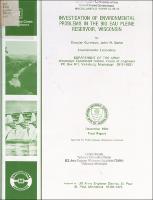Please use this identifier to cite or link to this item:
https://hdl.handle.net/11681/21452Full metadata record
| DC Field | Value | Language |
|---|---|---|
| dc.contributor.author | Gunnison, Douglas | - |
| dc.contributor.author | Barko, John W. | - |
| dc.date.accessioned | 2017-02-17T17:05:43Z | - |
| dc.date.available | 2017-02-17T17:05:43Z | - |
| dc.date.issued | 1988-12 | - |
| dc.identifier.uri | http://hdl.handle.net/11681/21452 | - |
| dc.description.abstract | Abstract: A study of environmental problems in the Big Eau Pleine Reservoir, Wisconsin, was undertaken in response to a request from the Wisconsin Department of Natural Resources to the US Army Engineer District, St. Paul, for planning assistance. The Big Eau Pleine Reservoir has had a history of winter fish kills and summer algal blooms since its construction in 1937 by the Wisconsin Valley Improvement Company. The US Army Engineer Waterways Experiment Station (WES) was asked to examine the results of previous studies and recommendations for water quality improvement and, if appropriate, to provide new recommendations. The WES scientists reviewed theses written by graduate students at the University of Wisconsin-Stevens Point, who had conducted research on the Big Eau Pleine Reservoir. The WES also examined existing data on dissolved oxygen, biochemical oxygen demand (BOB), and total and orthophosphate phosphorus. The FLUX interactive program for estimating loadings and mass discharges was applied to compute and compare BOD and total and orthophosphate phosphorus loadings in reservoir inflows and releases. Sediment cores were taken by WES personnel from a downstream area near the dam and in an upstream area where inflows are believed to deposit materials during spring runoff. Interstitial water samples from the cores were analyzed for a variety of chemical constituents. Results of the study indicated that the reservoir is a sink for total phosphorus but releases organic matter in the form of BOD. It was not possible to determine the degradability of organic matter deposited in the upstream delta or to ascertain how much of the reservoir phytoplankton production leaves the system or is degraded in the water column. Additional information on sediment transport, sedimentation rate, and sediment chemistry is required to fully understand the dynamics of sediment-water interactions in the reservoir. Further work is needed to comprehend the relationship between oxygen sags and chemical species released in the water column and to evaluate the effectiveness of an aerator installed in 1980. The WES scientists suggested several potential management alternatives and made recommendations for additional studies to provide the information needed to select the most suitable alternative(s). | en_US |
| dc.description.sponsorship | United States. Army. Corps of Engineers. St. Paul District. | en_US |
| dc.language.iso | en | en_US |
| dc.publisher | Environmental Laboratory (U.S.) | en_US |
| dc.relation.ispartofseries | Miscellaneous Paper;EL-88-18 | - |
| dc.subject | Big Eau Pleine Reservoir (Wis.)--Environmental aspects | en_US |
| dc.subject | Sediment oxygen demand | en_US |
| dc.subject | Biochemical oxygen demand | en_US |
| dc.subject | Dissolved oxygen depletion | en_US |
| dc.subject | Algal blooms | en_US |
| dc.subject | Water quality | en_US |
| dc.title | Investigation of environmental problems in the Big Eau Pleine Reservoir, Wisconsin | en_US |
| dc.type | Report | en_US |
| Appears in Collections: | Miscellaneous Paper | |
Files in This Item:
| File | Description | Size | Format | |
|---|---|---|---|---|
| MP EL-88-18.pdf | 8.12 MB | Adobe PDF |  View/Open |